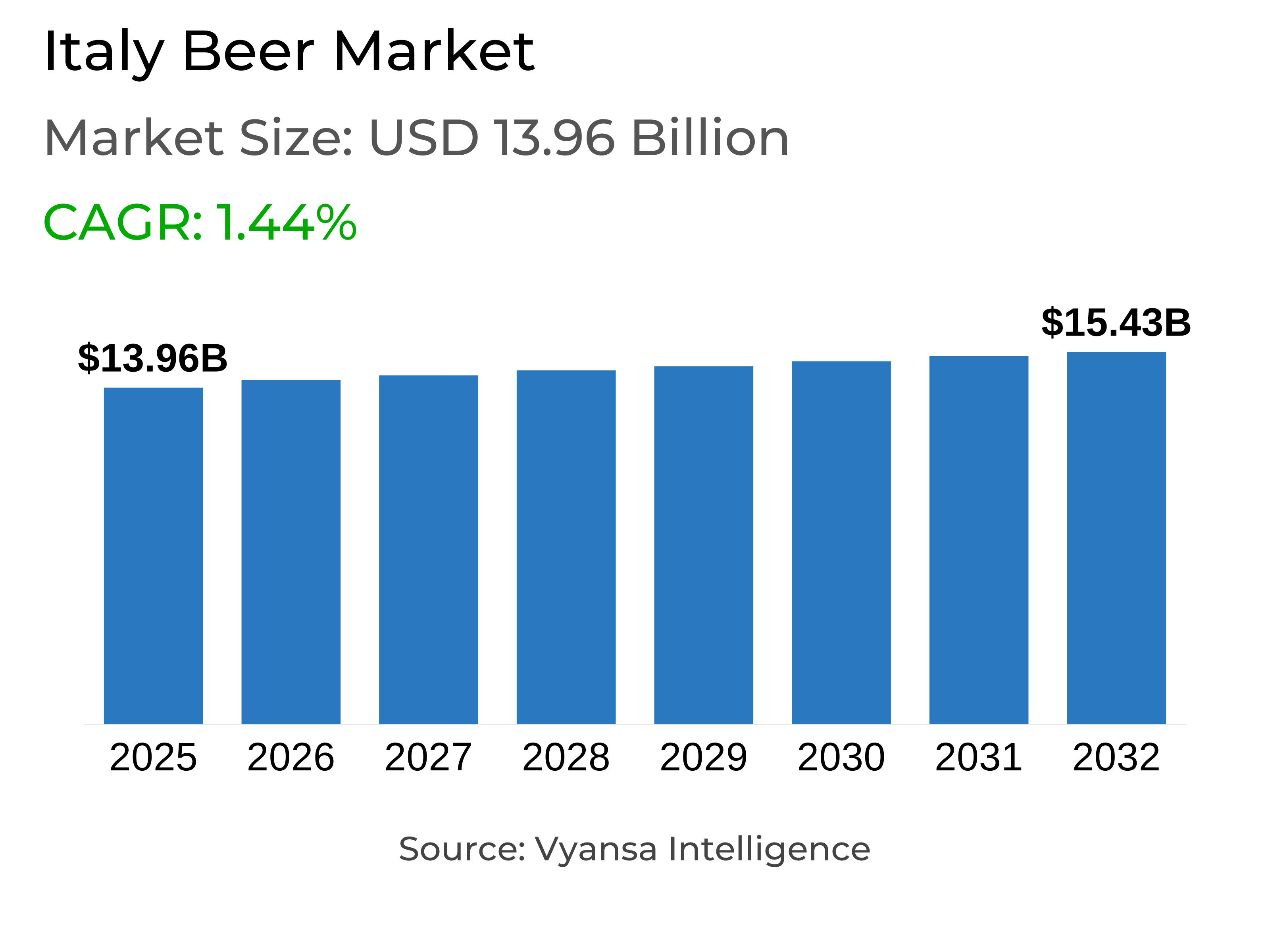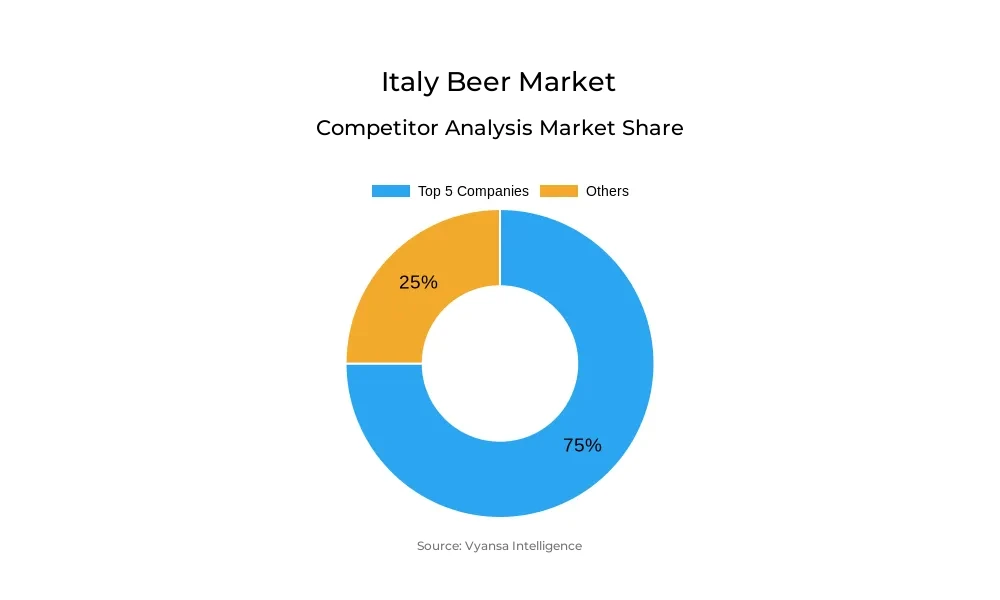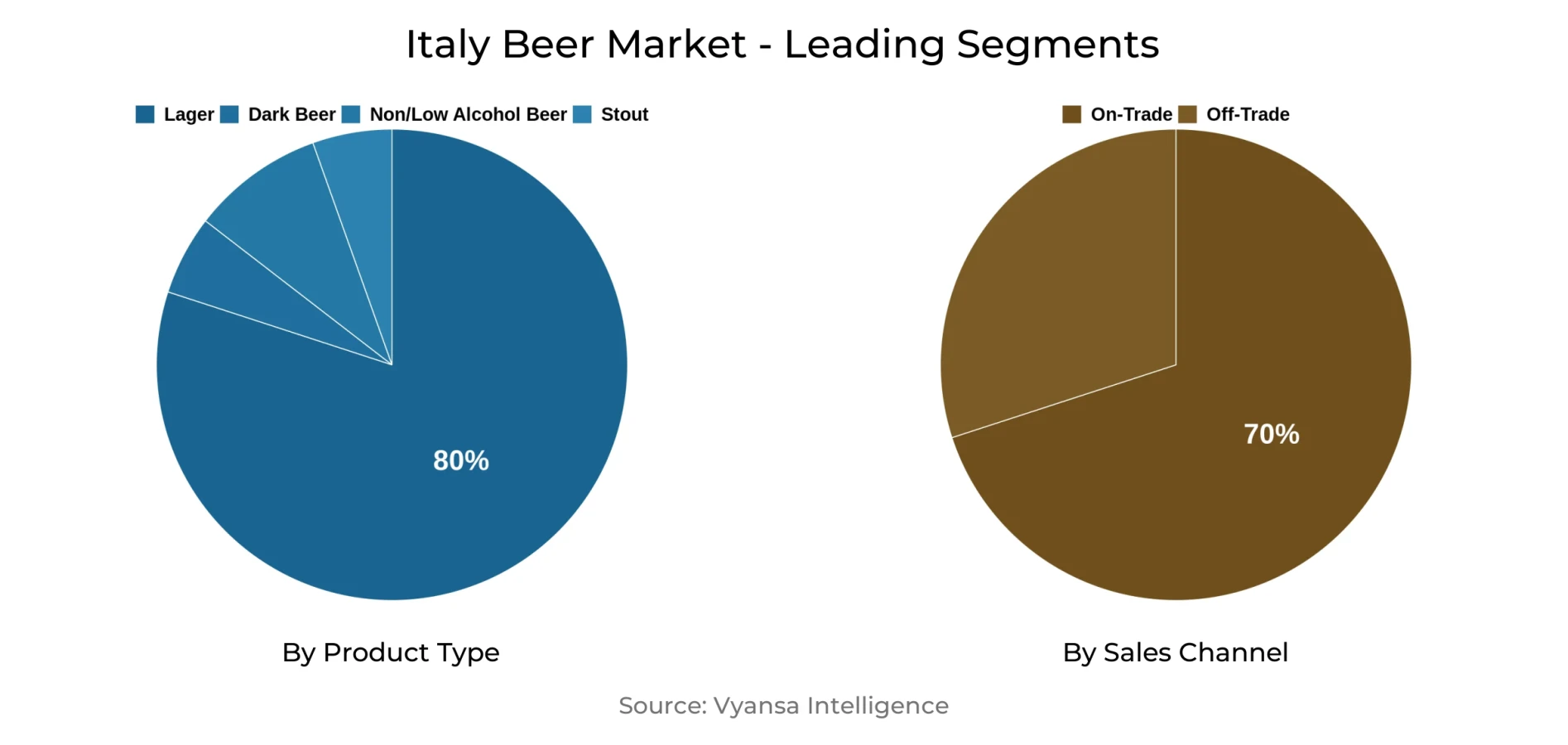Italy Beer Market Report: Trends, Growth and Forecast (2026-2032)
By Product Type (Dark Beer (Ale, Sorghum Beer, Weissbier/Weizen/Wheat Beer), Lager (Flavoured/Mixed Lager, Standard Lager (Premium Lager (Domestic Premium Lager, Imported Premium Lager), Mid-Priced Lager (Domestic Mid-Priced Lager, Imported Mid-Priced Lager), Economy Lager (Domestic Economy Lager, Imported Economy Lager))), Non/Low Alcohol Beer (Low Alcohol Beer, Non Alcoholic Beer), Stout, Others (Porter, Malt etc.)), By Production (Macro Brewery, Micro Brewery, Craft Brewery), By Packaging Type (Bottles, Cans, Others), By Sales Channel (On-Trade, Off-Trade)
- Food & Beverage
- Dec 2025
- VI0599
- 110
-




Italy Beer Market Statistics and Insights, 2026
- Market Size Statistics
- Beer in italy is estimated at USD 13.96 billion.
- The market size is expected to grow to USD 15.43 billion by 2032.
- Market to register a cagr of around 1.44% during 2026-32.
- Product Type Shares
- Lager grabbed market share of 80%.
- Lager to witness a volume cagr of around 0.75%.
- Competition
- More than 20 companies are actively engaged in producing beer in italy.
- Top 5 companies acquired around 75% of the market share.
- Birra Forst SpA, Ceres Italia SpA, Bavaria Italia srl, Heineken Italia SpA, Birra Peroni Srl etc., are few of the top companies.
- Sales Channel
- On-trade grabbed 70% of the market.
Italy Beer Market Outlook
The Italy beer market is currently at $13.96 billion in 2025 and is projected to reach $15.43 billion by 2032 at a CAGR of about 1.44% between 2026–2032. Beer sales are likely to increase moderately in overall volume terms underpinned by stabilising prices and improving end users confidence. Off-trade will be driven by promotions and the sustained appeal of local lager, whereas on-trade will continue to be a primary value sales driver, representing 70% of the market, as end users will keep drinking beer in pubs, restaurants, and social occasions.
With an 80% market share, Lager is expected to have a volume CAGR of approximately 0.75%. Peroni, Moretti, and Heineken will continue to be value drivers in the mid-range and premium lager segments, as low and non-alcoholic beers gain traction in sales due to increased health awareness and regulations concerning responsible drinking. Craft and specialist beer will incrementally gain some traction as consumers try new & interesting flavours and local ingredients.
The craft beer segment is expected to have continued growth through the forecast period, driven by consumer demand for premium and specialty products. Both micro-breweries and existing players will invest in innovation related to introducing new flavours, sharing seasonal products and offering products to help customers select complementary food pairings. Domestic craft beer brands that include Italy ingredients (such as herbs and fruits) will grow through inbound tourists as well as more consumers participating in beer tours & tastings.
Retail online will supplement off-trade channels, offering access to specialty and craft beer. Lager will continue to be the market's backbone, but low alcohol, non-alcoholic, ale, and premium product innovation will draw younger end users as well as those who are interested in healthier or more upscale choices. Total Italy beer market growth will be steady, moderate, fueled by product diversification and a revival of interest in premium and craft beers.

Italy Beer Market Growth DriverPrice Stabilisation Increases end users Confidence
Price stabilisation helps Italy beer, where end users are supported to keep or boost purchases in domestic premium, mid-range, and economy lager segments. Following inflation-led price increases, stabilised prices help lower uncertainty, enabling shoppers to plan and make purchases with confidence. Brand staples like Peroni and Moretti enjoy robust demand, bolstered by promotions targeted at price-sensitive end users.
Steady pricing, along with continuous promotional efforts, maintains end users loyalty and drives repeat buys. In the meantime, non/low alcohol beer complements mainstream lagers, drawing health-aware end users without eroding core volume. Collectively, these elements drive a favorable climate for total beer volume and value growth, which allows incumbent players and new breweries to consolidate their market base.
Italy Beer Market TrendShift Towards Health-Conscious Beers Gains Traction
Italy end users increasingly practice health-aware consumption patterns, fuelling non/low alcohol beer growth. Younger generations, especially Millennials, are embracing the value of mindful consumption, preferring beverages with lower alcohol content or functional attributes. Buckler, Moretti Zero, and Heineken 0.0 are all performing well, underlining the growing significance of wellness-oriented decisions in beer.
Innovation in craft and low-alcohol markets further fuels the trend. Breweries are launching distinctive flavors, limited releases, and innovative brewing methods to address changing tastes. Healthy options redefine buying patterns, prompting traditional brewers to diversify their portfolios and invest in alternative formulations, making the market more vibrant and competitive.
Italy Beer Market OpportunityExpansion of Craft Innovation
The Italy beer market is going to gain from the expansion of craft innovation in low-alcohol, non-alcoholic, and premium ale categories. Craft breweries are launching special flavors, specialty ingredients, and distinctive packaging, appealing to end users looking for differentiation and premium experiences.
Growing interest in local ingredients and innovative brewing methods offers further opportunities for innovation. Festivals, brewery tours, and social media initiatives are likely to drive greater visibility and participation. This environment enables both craft and larger brewers to enhance product lines, target new end users groups, and increase overall sales in a market increasingly interested in premium and new product offerings.
Italy Beer Market Segmentation Analysis

By Product Type
- Dark Beer
- Lager
- Non/Low Alcohol Beer
- Stout
The segment with highest market share under Product Type is lager, whose maximum market share is approximately 80%. Lager leads the Italy beer market with strong domestic brands such as Peroni, Moretti, and Heineken. Mid-priced lagers are the most sought-after option for daily consumption, while premium lagers find takers among end users who are looking for quality and sophistication. Economy lagers also have a presence, especially in price-conscious homes, but their proportion is smaller relative to mid-range and premium segments.
Throughout the forecast period, lager is predicted to experience a volume CAGR of about 0.75%, underpinning moderate growth. As low alcohol and craft beer continue to capture the attention of younger drinkers and health-aware end users, however, lager remains at the forefront of the Italy beer market. Innovation in craft and premium lagers, through flavour extensions and new packaging lines, will likely continue to underpin end users interest and ensure ongoing dominance for the segment.
By Sales Channel
- On-Trade
- Off-Trade
The segment with highest market share under Sales Channel is on-trade, and this largest market share is approximately 70%. On-trade venues such as bars, pubs, and restaurants are still a dominant channel for the consumption of beer in Italy. end users still appreciate social occasions of drinking, where premium lagers, ales, and craft beers tend to be the drink of choice due to the distinct flavours and greater perceived value.
Throughout the forecast period, on-trade will continue to be the leading channel even when faced with competition from off-trade and e-commerce. Breweries will be likely to concentrate on building closer ties with on-trade operators through exclusive products, promotions, and events to entice end users. The channel will be driven by innovations in craft beer, low alcohol drinks, and increasingly the interest in pairing beer with food, which fosters higher value sales and underpins overall market growth.
Top Companies in Italy Beer Market
The top companies operating in the market include Birra Forst SpA, Ceres Italia SpA, Bavaria Italia srl, Heineken Italia SpA, Birra Peroni Srl, InBev Italia srl, Birra Castello SpA, Carlsberg Italia SpA, Dibevit Import Srl, Paulaner Italia Srl, etc., are the top players operating in the italy beer market.
Frequently Asked Questions
Related Report
1. Market Segmentation
1.1. Research Scope
1.2. Research Methodology
1.3. Definitions and Assumptions
2. Executive Summary
3. Italy Beer Market Policies, Regulations, and Standards
4. Italy Beer Market Dynamics
4.1. Growth Factors
4.2. Challenges
4.3. Trends
4.4. Opportunities
5. Italy Beer Market Statistics, 2022-2032F
5.1. Market Size & Growth Outlook
5.1.1. By Revenues in US$ Million
5.1.2. By Quantity Sold in Million Litres
5.2. Market Segmentation & Growth Outlook
5.2.1. By Product Type
5.2.1.1. Dark Beer- Market Insights and Forecast 2022-2032, USD Million
5.2.1.1.1. Ale- Market Insights and Forecast 2022-2032, USD Million
5.2.1.1.2. Sorghum Beer- Market Insights and Forecast 2022-2032, USD Million
5.2.1.1.3. Weissbier/Weizen/Wheat Beer- Market Insights and Forecast 2022-2032, USD Million
5.2.1.2. Lager- Market Insights and Forecast 2022-2032, USD Million
5.2.1.2.1. Flavoured/Mixed Lager- Market Insights and Forecast 2022-2032, USD Million
5.2.1.2.2. Standard Lager- Market Insights and Forecast 2022-2032, USD Million
5.2.1.2.2.1. Premium Lager- Market Insights and Forecast 2022-2032, USD Million
5.2.1.2.2.1.1. Domestic Premium Lager- Market Insights and Forecast 2022-2032, USD Million
5.2.1.2.2.1.2. Imported Premium Lager- Market Insights and Forecast 2022-2032, USD Million
5.2.1.2.2.2. Mid-Priced Lager- Market Insights and Forecast 2022-2032, USD Million
5.2.1.2.2.2.1. Domestic Mid-Priced Lager- Market Insights and Forecast 2022-2032, USD Million
5.2.1.2.2.2.2. Imported Mid-Priced Lager- Market Insights and Forecast 2022-2032, USD Million
5.2.1.2.2.3. Economy Lager- Market Insights and Forecast 2022-2032, USD Million
5.2.1.2.2.3.1. Domestic Economy Lager- Market Insights and Forecast 2022-2032, USD Million
5.2.1.2.2.3.2. Imported Economy Lager- Market Insights and Forecast 2022-2032, USD Million
5.2.1.3. Non/Low Alcohol Beer- Market Insights and Forecast 2022-2032, USD Million
5.2.1.3.1. Low Alcohol Beer- Market Insights and Forecast 2022-2032, USD Million
5.2.1.3.2. Non Alcoholic Beer- Market Insights and Forecast 2022-2032, USD Million
5.2.1.4. Stout- Market Insights and Forecast 2022-2032, USD Million
5.2.1.5. Others (Porter, Malt etc.) - Market Insights and Forecast 2022-2032, USD Million
5.2.2. By Production
5.2.2.1. Macro Brewery- Market Insights and Forecast 2022-2032, USD Million
5.2.2.2. Micro Brewery- Market Insights and Forecast 2022-2032, USD Million
5.2.2.3. Craft Brewery- Market Insights and Forecast 2022-2032, USD Million
5.2.3. By Packaging Type
5.2.3.1. Bottles- Market Insights and Forecast 2022-2032, USD Million
5.2.3.2. Cans- Market Insights and Forecast 2022-2032, USD Million
5.2.3.3. Others- Market Insights and Forecast 2022-2032, USD Million
5.2.4. By Sales Channel
5.2.4.1. On-Trade- Market Insights and Forecast 2022-2032, USD Million
5.2.4.2. Off-Trade- Market Insights and Forecast 2022-2032, USD Million
5.2.5. By Competitors
5.2.5.1. Competition Characteristics
5.2.5.2. Market Share & Analysis
6. Italy Dark Beer Market Statistics, 2022-2032F
6.1. Market Size & Growth Outlook
6.1.1. By Revenues in US$ Million
6.1.2. By Quantity Sold in Million Litres
6.2. Market Segmentation & Growth Outlook
6.2.1. By Product Type- Market Insights and Forecast 2022-2032, USD Million
6.2.2. By Production- Market Insights and Forecast 2022-2032, USD Million
6.2.3. By Packaging Type- Market Insights and Forecast 2022-2032, USD Million
6.2.4. By Sales Channel- Market Insights and Forecast 2022-2032, USD Million
7. Italy Lager Beer Market Statistics, 2022-2032F
7.1. Market Size & Growth Outlook
7.1.1. By Revenues in US$ Million
7.1.2. By Quantity Sold in Million Litres
7.2. Market Segmentation & Growth Outlook
7.2.1. By Product Type- Market Insights and Forecast 2022-2032, USD Million
7.2.2. By Production- Market Insights and Forecast 2022-2032, USD Million
7.2.3. By Packaging Type- Market Insights and Forecast 2022-2032, USD Million
7.2.4. By Sales Channel- Market Insights and Forecast 2022-2032, USD Million
8. Italy Non/Low Alcohol Beer Market Statistics, 2022-2032F
8.1. Market Size & Growth Outlook
8.1.1. By Revenues in US$ Million
8.1.2. By Quantity Sold in Million Litres
8.2. Market Segmentation & Growth Outlook
8.2.1. By Production- Market Insights and Forecast 2022-2032, USD Million
8.2.2. By Packaging Type- Market Insights and Forecast 2022-2032, USD Million
8.2.3. By Sales Channel- Market Insights and Forecast 2022-2032, USD Million
9. Italy Stout Beer Market Statistics, 2022-2032F
9.1. Market Size & Growth Outlook
9.1.1. By Revenues in US$ Million
9.1.2. By Quantity Sold in Million Litres
9.2. Market Segmentation & Growth Outlook
9.2.1. By Production- Market Insights and Forecast 2022-2032, USD Million
9.2.2. By Packaging Type- Market Insights and Forecast 2022-2032, USD Million
9.2.3. By Sales Channel- Market Insights and Forecast 2022-2032, USD Million
10. Competitive Outlook
10.1.Company Profiles
10.1.1. Heineken Italia SpA
10.1.1.1. Business Description
10.1.1.2. Product Portfolio
10.1.1.3. Collaborations & Alliances
10.1.1.4. Recent Developments
10.1.1.5. Financial Details
10.1.1.6. Others
10.1.2. Birra Peroni Srl
10.1.2.1. Business Description
10.1.2.2. Product Portfolio
10.1.2.3. Collaborations & Alliances
10.1.2.4. Recent Developments
10.1.2.5. Financial Details
10.1.2.6. Others
10.1.3. InBev Italia srl
10.1.3.1. Business Description
10.1.3.2. Product Portfolio
10.1.3.3. Collaborations & Alliances
10.1.3.4. Recent Developments
10.1.3.5. Financial Details
10.1.3.6. Others
10.1.4. Birra Castello SpA
10.1.4.1. Business Description
10.1.4.2. Product Portfolio
10.1.4.3. Collaborations & Alliances
10.1.4.4. Recent Developments
10.1.4.5. Financial Details
10.1.4.6. Others
10.1.5. Carlsberg Italia SpA
10.1.5.1. Business Description
10.1.5.2. Product Portfolio
10.1.5.3. Collaborations & Alliances
10.1.5.4. Recent Developments
10.1.5.5. Financial Details
10.1.5.6. Others
10.1.6. Birra Forst SpA
10.1.6.1. Business Description
10.1.6.2. Product Portfolio
10.1.6.3. Collaborations & Alliances
10.1.6.4. Recent Developments
10.1.6.5. Financial Details
10.1.6.6. Others
10.1.7. Ceres Italia SpA
10.1.7.1. Business Description
10.1.7.2. Product Portfolio
10.1.7.3. Collaborations & Alliances
10.1.7.4. Recent Developments
10.1.7.5. Financial Details
10.1.7.6. Others
10.1.8. Bavaria Italia srl
10.1.8.1. Business Description
10.1.8.2. Product Portfolio
10.1.8.3. Collaborations & Alliances
10.1.8.4. Recent Developments
10.1.8.5. Financial Details
10.1.8.6. Others
10.1.9. Dibevit Import Srl
10.1.9.1. Business Description
10.1.9.2. Product Portfolio
10.1.9.3. Collaborations & Alliances
10.1.9.4. Recent Developments
10.1.9.5. Financial Details
10.1.9.6. Others
10.1.10. Paulaner Italia Srl
10.1.10.1. Business Description
10.1.10.2. Product Portfolio
10.1.10.3. Collaborations & Alliances
10.1.10.4. Recent Developments
10.1.10.5. Financial Details
10.1.10.6. Others
11. Disclaimer
| Segment | Sub-Segment |
|---|---|
| By Product Type |
|
| By Production |
|
| By Packaging Type |
|
| By Sales Channel |
|
Research Methodology
This study followed a structured approach comprising four key phases to assess the size and scope of the electro-oxidation market. The process began with thorough secondary research to collect data on the target market, related markets, and broader industry context. These findings, along with preliminary assumptions and estimates, were then validated through extensive primary research involving industry experts from across the value chain. To calculate the overall market size, both top-down and bottom-up methodologies were employed. Finally, market segmentation and data triangulation techniques were applied to refine and validate segment-level estimations.
Secondary Research
The secondary research phase involved gathering data from a wide range of credible and published sources. This step helped in identifying industry trends, defining market segmentation, and understanding the market landscape and value chain.
Sources consulted during this phase included:
- Company annual reports, investor presentations, and press releases
- Industry white papers and certified publications
- Trade directories and market-recognized databases
- Articles from authoritative authors and reputable journals
- Gold and silver standard websites
Secondary research was critical in mapping out the industry's value chain and monetary flow, identifying key market segments, understanding regional variations, and tracking significant industry developments.
Other key sources:
- Financial disclosures
- Industry associations and trade bodies
- News outlets and business magazines
- Academic journals and research studies
- Paid industry databases
Primary Research
To validate secondary data and gain deeper market insights, primary research was conducted with key stakeholders across both the supply and demand sides of the market.
On the demand side, participants included decision-makers and influencers from end-user industries—such as CIOs, CTOs, and CSOs—who provided first-hand perspectives on market needs, product usage, and future expectations.
On the supply side, interviews were conducted with manufacturers, industry associations, and institutional participants to gather insights into current offerings, product pipelines, and market challenges.
Primary interviews provided critical inputs such as:
- Market size and revenue data
- Product and service breakdowns
- Market forecasts
- Regional and application-specific trends
Stakeholders consulted included:
- Leading OEM and solution providers
- Channel and distribution partners
- End users across various applications
- Independent consultants and industry specialists
Market Size Estimation and Data Triangulation
- Identifying Key Market Participants (Secondary Research)
- Goal: To identify the major players or companies in the target market. This typically involves using publicly available data sources such as industry reports, market research publications, and financial statements of companies.
- Tools: Reports from firms like Gartner, Forrester, Euromonitor, Statista, IBISWorld, and others. Public financial statements, news articles, and press releases from top market players.
- Extracting Earnings of Key Market Participants
- Goal: To estimate the earnings generated from the product or service being analyzed. This step helps in understanding the revenue potential of each market player in a specific geography.
- Methods: Earnings data can be gathered from:
- Publicly available financial reports (for listed companies).
- Interviews and primary data sources from professionals, such as Directors, VPs, SVPs, etc. This is especially useful for understanding more nuanced, internal data that isn't publicly disclosed.
- Annual reports and investor presentations of key players.
- Data Collation and Development of a Relevant Data Model
- Goal: To collate inputs from both primary and secondary sources into a structured, data-driven model for market estimation. This model will incorporate key market KPIs and any independent variables relevant to the market.
- Key KPIs: These could include:
- Market size, growth rate, and demand drivers.
- Industry-specific metrics like market share, average revenue per customer (ARPC), or average deal size.
- External variables, such as economic growth rates, inflation rates, or commodity prices, that could affect the market.
- Data Modeling: Based on this data, the market forecasts are developed for the next 5 years. A combination of trend analysis, scenario modeling, and statistical regression might be used to generate projections.
- Scenario Analysis
- Goal: To test different assumptions and validate how sensitive the market is to changes in key variables (e.g., market demand, regulatory changes, technological disruptions).
- Types of Scenarios:
- Base Case: Based on current assumptions and historical data.
- Best-Case Scenario: Assuming favorable market conditions, regulatory environments, and technological advancements.
- Worst-Case Scenario: Accounting for adverse factors, such as economic downturns, stricter regulations, or unexpected disruptions.
Partnering With Industry Leaders to Drive Growth
Our mission is to deliver intelligence that matters. By combining data, analysis, and industry expertise, we enable organizations to make smarter, faster, and more impactful decisions. Whether it’s a Fortune 500 company or a high-growth startup, businesses trust us to provide clarity in an ever-evolving marketplace.






